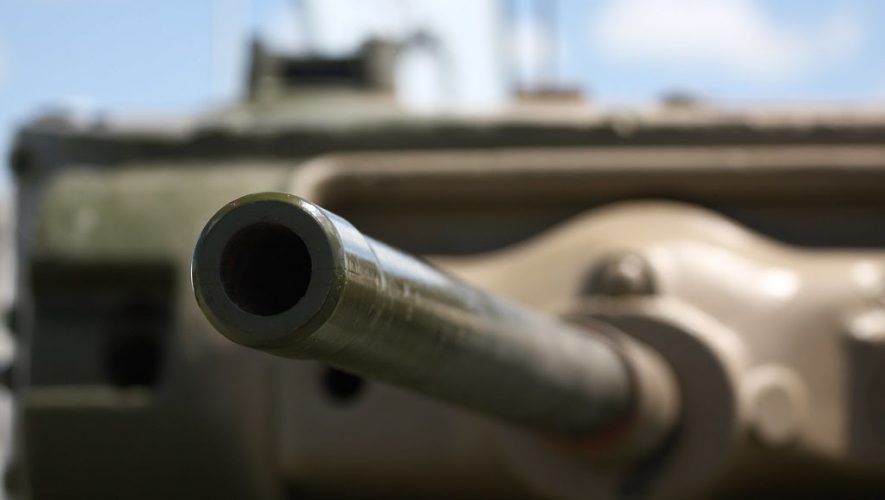America’s executive branch has systemically failed to evaluate state stability when sending billions of dollars of weapons abroad. The country’s defense trade lacks cogent rationale, amplifies risks, and results in countless unintended consequences. The trade exacerbates conflicts and costs American lives.
Between 2002 and 2018, the US sold a conservative estimate of $560 billion in major conventional weapons to 168 nations. The classification excludes weapons of mass destruction, but covers combat vehicles, helicopters, aircraft, warships, small arms, landmines, cluster munitions, ammunition, and artillery. America’s riskiest customers—as measured by corruption, stability, involvement in domestic or international conflict, and treatment of citizens—include Iraq, Afghanistan, Columbia, India, Nigeria, the Philippines, and Saudi Arabia.
While the US dabbled in the international defense trade well before World War II, the Cold War triggered mass arms sales. Federal investment in the research and development of modern weapons surged along with international demand for American armaments. The country embraced arms sales to improve its allies’ defense capabilities, an approach that continues today.
President Richard Nixon used weapon transfers extensively during the Vietnam War to “wield force and exert influence” while keeping additional American troops at home. In the early 1970s, Nixon quietly increased arms sales tenfold, generally without notifying Congress or the public. Unrestricted, Nixon took extensive covert action, inciting Congress to amend defense trade policy to curb the executive branch.
In 1976, Congress passed the Arms Export Controls Act (AECA), which established the modern arms sales process. So long as the executive branch complies with the AECA and other laws, it can sell arms unless congressional legislation modifies or halts the deal. The AECA also formalized and codified the role of the executive office in negotiation and approval, mandating that the Department of State (DOS) and the Department of Defense complete geopolitical and military risk assessments. These evaluations must consider whether a sale would contribute to weapons of mass destruction, international terrorism, conflict esclation, delays in nonproliferation agreements, or an arms race.
While the AECA seemed like a step in the right direction, it is pragmatically impotent.
According to the DOS, the US considers “the political, military, economic, arms control, and human rights” conditions of each country, avowedly approving only the transfers that benefit American foreign policy and national security interests. In practice, financial considerations take priority. President Bill Clinton neglected regime type and ideology, focusing solely on economic gain. By 1993, the US dominated the third-world market with $36 billion in revenue and a 72 percent share.
Counterintuitively, 9/11 prompted a boom in US weapons exports. While the Bush administration illegally waged war in Iraq over an unsubstantiated claim linking their president to Al-Qaeda, the US gained one of its best—and riskiest—customers. From 2002 to 2018, the US sold $9.9 billion of weapons to Iraq, making it America’s seventh-highest-paying customer.
Beyond these logical lapses, the war on terror led to more diluted risk assessments. The Bush and Obama administrations justified selling arms to previously unapproved countries by citing the urgency to combat terrorism. Under these presidencies, violating human rights and engaging in conflicts did not disqualify a buyer.
Despite these glaring imperfections, the DOS characterizes the defense trade as a pivotal foreign policy tool. The US has leveraged arms sales to push countries to vote with its interests at the United Nations or adopt pro-US foreign policy. For instance, America has used arms sales to persuade Egypt and Israel to accept peace accords and to establish military bases in countries including Greece, Turkey, Kenya, Somalia, Oman, and the Philippines.
The defense trade is attractive to the executive branch for the same reasons it always has been: it reduces American troop deployment, provides flexibility in military interventions, brings more clout in negotiations, and costs little financially or politically. Arms sales are not dependent on defense budgets or an arduous congressional process, making them easily employable. These sales are also perceived as beneficial to the American economy and typically result in no political backlash. Even when weapons sales are clearly not the best option, presidents will be inclined to choose it.
Arms sales can, in selective contexts, serve an important function in American foreign policy, but the gains are overstated and the consequences overlooked. While weapons sales are purported to save American lives, these transactions create conflicts that often require intervention. There are two primary shortcomings to weapons sales: blowback—when American weapons are used against American interests—and dispersion, when weapons sold to foreign governments are transferred to terrorists or criminal groups.
Selling arms to a majority of countries and intervening in military conflicts makes blowback an inevitable side-effect. Blowback occurs when former allies become hostile. In 1989, General Manuel Noriega, a dictator and former CIA asset, nullified the national election and declared his country—one home to about thirty-five thousand American expats—to be in a state of war with the US. The consequential intervention by President George H.W. Bush resulted in the deployment of 27,684 US troops and over three hundred aircraft to face a new regime equipped with American weapons. When the dust settled, three civilians and twenty-three soldiers were killed—324 more service members were wounded.
A similar situation occurred in Iran. To provide a stabilizing influence in the Middle East in the 1970s, the US conducted multi-billion-dollar transactions of sophisticated conventional weaponry to the Shah of Iran. However, the 1979 Iranian Revolution gave power to a despotic regime that eventually used American weapons in its war with Iraq in 1980.
Selling weapons to neutral countries or non-state actors can also result in blowback. In response to Iran’s aggression, the US provided Iraq with weapons worth billions of dollars, only to face those very weapons while countering the Iraqi annexation of Kuwait in 1990. In another case, the US sold weapons to Somalia throughout the 1980s, only to intervene to assist with famine relief during the civil war in 1993, resulting in the death of eighteen American soldiers.
Dispersion is irrevocably connected to blowback and can occur through sale and theft. In the 1980s, the Reagan administration provided the Afghani Mujahideen with Stinger missiles to fight the Soviet Union. While the strategy was effective at the time, the Mujahideen eventually sold the weapons to hostile states including North Korea and Iran. Alternatively, the Islamic State of Iraq and the Levant (ISIL) has consistently stolen American-manufactured humvees, tanks, and armaments. In 2014, the United Nations Security Council reported that “ISIL is particularly well-armed given its access to extensive supplies of heavy weapons seized from the Government of Iraq.”
While it is impossible to predict the long-term consequences of arms sales, denying transaction requests from fragile governments is one of the most foolproof methods of reducing risk. Even though it was strategically advantageous to sell arms to Iraq, the destabilized country was home to and affiliated with numerous terrorist organizations, making it a weak candidate to receive American weapons.
That said, the US has attempted to implement procedures to prevent dispersion through programs like Blue Lantern and Golden Sentry that regulate the use, transfer, and security of weapons through end-use monitoring (EUM). EUM can require scheduled inspections, inventories, and record reviews by the US government. While comprehensive on paper, it has failed in practice. Although these mechanisms can bar countries from purchasing armaments directly from the US, it does not prevent weapons from being transferred to volatile or even hostile actors.
Without effective regulation, US arms become tools that combat American troops and interests. Through its defense trade, the US has inadvertently propagated and prolonged conflicts, further eroding regional stability and increasing the likelihood of future American intervention. Arms transfers have a strong correlation to war; they intensify and draw out conflicts, as evidenced by data from African countries. Further, countries that receive major conventional weapons are 70 percent more likely to enter civil war. Access to more weapons only encourages and intensifies violence.
Furthermore, some states perceive US arms trade policy as combative, spurring them to take drastic measures. In the summer of 2019, the Trump administration organized the sale of $2.2 billion in missiles and tanks and $8 billion in fighter jets to Taiwan. The US cited the 1971 Taiwan Relations Act, which commited America to protect Taiwan from China. A Taiwanese defense official confirmed that when America sells Taiwan the latest fighters, “it lets China know America would intervene on our behalf in a conflict.” The Xi administration—already hostile to the US because of Trump’s trade war—responded uncharacteristically by threatening sanctions on all companies involved with the transaction.
Despite the exacerbatory effects of blowback and dispersion on conflict, President Trump has continued America’s legacy of prioritizing profit over American lives. In 2018, the Trump administration informed Congress of weapons sales totaling over $78 billion, securing American dominance of the global arms market at 31 percent.
The president has defended selling arms to unstable countries by citing exaggerated figures describing the industry’s economic impact, particularly on job creation. However, even the most generous assessment of the industry shows that arms-sales-related jobs comprise 0.02 percent of the United States’ labor force. Nevertheless, as tensions with North Korea escalated in 2017, Trump encouraged Asian allies to purchase more American weapons, pronouncing that “it’s a lot of jobs for us and a lot of safety for Japan.”
In 2017, Trump negotiated a $100 billion agreement with Saudi Arabia, a country criticized for committing numerous human rights violations in Yemen—most notably, the killing of civilians during airstrikes. Despite the Trump administration’s clear support for the deal, there is bipartisan support for restricting US arms sales to Saudi Arabia. In June 2019, Congress passed three bipartisan resolutions to block Trump’s sale of more than $8 billion in weapons to Saudi Arabia and the United Arab Emirates, but the president vetoed all three. While Congress attempted to overrule his veto, they lacked the required two-thirds majority even with the support of established Republican Senators Lindsey Graham, Susan Collins, and Rand Paul.
In response to the bipartisan backlash, the Trump administration is considering ending congressional review. The reform would fast-track transactions to countries like Saudi Arabia regardless of humanitarian concerns. Under the current system, the foreign policy congressional committees are informally notified of sales, allowing lawmakers to recommend edits. However, if the notification process is ended, the circumvention of congressional oversight could result in more reckless sales.
Regardless of who wins the November election, it seems that this precedent will persevere. While presumptive Democratic nominee Joe Biden has pledged to cease weapons sales to Saudi Arabia, he has not released any foreign policy strategy, let alone a blueprint for America’s role in the international defense trade. Though Saudi arms sales policy was a hot-button issue throughout the Democratic primary, none of the candidates expressed intentions to amend the AECA to limit presidential authority over the defense trade.
The US must dramatically reduce its arms sales to grant itself more diplomatic leverage. In the past, the US promoted the nonproliferation of arms and nuclear weapons, but countless military interventions since 2001 have tainted that credibility. In order to regain moral authority, the US would need to modify its sales policy. Furthermore, by not arming countries in conflict, the US can serve as a neutral broker of peace. The challenge of facilitating negotiations between feuding countries while arming one side is self-evident from the ongoing Israel–Palestine and Saudi Arabia–Iran conflicts; the US attempted to mediate in both, but failed because it was not neutral.
The first step to reforming America’s defense trade is reassessing which countries qualify to purchase arms. The current methodology for determining risk is clearly flawed because the assessment is not highly valued or strictly enforced. History indicates that the government does not seriously consider a country’s stability. Once the risk assessment process is amended, all transactions to volatile nations should be suspended.
In addition to selling less weaponry, the US must refine its accountability mechanism for states purchasing weapons. The inadequate EUM system should be expanded to prevent the misuse of American weapons through increased monitoring. Although EUM was developed to prevent foreign governments from selling to non-state actors, it does not hold states accountable for how they use those weapons. Stronger enforcement would prevent unstable countries from purchasing arms and reduce the number of actors receiving weapons.
The most controversial reform that experts recommend is amending the AECA to require congressional approval for all arms sales. In the name of transparency, the AECA requires that the president inform Congress of upcoming arms sales above a certain monetary value; then Congress has thirty days to block these transactions with a resolution.
When the AECA was drafted, Congress avoided taking an active role in weapons trade primarily to evade political plights. Those who criticize the defense industry risk losing the financial support of a powerful lobby that spends over $100 million annually. Members of Congress are further incentivized to support arms deals because it creates a positive image of supporting national security and American manufacturing. As such, it is unlikely Congress will want direct control or that such control, if granted, would impede arms sales.
Another challenge is getting the supermajority necessary to block arms sales. Even with bipartisan issues, achieving two-thirds support in both houses of Congress is extremely difficult. This demanding provision of the AECA has essentially granted the executive branch total jurisdiction over sales. Congress has yet to block one.
Despite the executive monopoly over arms deals, congressional oversight of the defense trade is substantiated through the Constitution by the Necessary and Proper Clause, the power to declare war, the power to regulate commerce with foreign nations, and general powers over foreign affairs. As such, Congress should monitor arms sales.
If the AECA were amended to require that Congress approve all arms deals, future sales would be subject to an additional check—heightened public scrutiny. Congressional oversight encourages greater deliberation on the strategic benefit of deals and increases civilian and media engagement. With such attention, the president would have to worry about generating enough popular support to gain congressional approval. If the Trump administration follows through with the reform it’s considering, Congress would be limited to the formal time frame of thirty days to gain the required supermajority to block risky deals. American arms policy needs more, not less, congressional oversight.
In 2019, 70 percent of Americans identified international arms sales as a threat to American security. This opposition is also bipartisan; 75 percent of Democrats, 70 percent of independents, and 62 percent of Republicans expressed a lack of safety associated with arms sales.
Reforming the defense trade is long overdue. Under America’s arms sales policy, the country has sold arms to 110 non-allies from 2002 to 2018. Further, the CATO Institute found that 81 percent of customers were “not free” countries and 67 percent placed in the worst category for political violence. These sales have continually damaged national interests, all while propping up authoritarian regimes, encouraging aggressive military strategy, spurring arms races, and exacerbating conflicts.
The defense trade is not just another commercial industry and should not be treated as such. Selling arms to regimes that are unstable or abuse human rights has consistently backfired, causing more armed conflicts, collateral damage, and lost lives. The international demand for arms will likely never fall, but the US should not participate in such a problematic and immoral industry.



